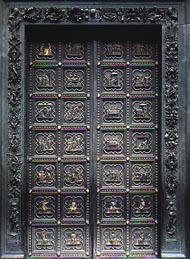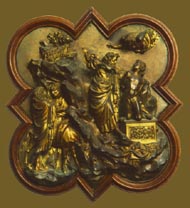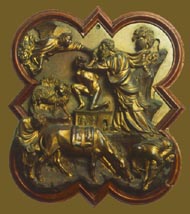Baptistry Competition
Art Home | ARTH Courses | ARTH 213 Assignments
Baptistry Competition
Few buildings in Florence have as much significance to the life of the city as the Baptistry. Opposite the west facade of the Duomo, the Baptistry is at the religious center of Florence. The building was dedicated to St. John the Baptist, the patron saint of Florence. It is in this building up until recent years that every Florentine citizen received the sacrament of Baptism. This building is thus critical in the religious and social identity of the city.
The current building was probably built between 1059 and 1150 , and it is an excellent example of Tuscan Romanesque architecture. In the thirteenth century, it was believed that the building was built as early as the mid-sixth century and had been designed as a copy of Lateran Baptistry in Rome, the most important baptistry in Christendom. Another legend, developed during the thirteenth and fourteenth century, traced the foundation of the Baptistry back to a Roman temple of Mars that was subsequently rededicated to St. John the Baptist. The Baptistry was thus the principal monument in Florence associated with the ancient Roman foundation of the city.
The Arte del Calimala, the wool merchants' guild, from as early as 1157 but at least by 1182 was given responsibility for the maintenance and embellishment of the building. The Calimala was the wealthiest and most influential of the major guilds. Established in the twelfth century, the guild was composed of dealers and refiners of foreign cloth and the wool importers as well as importers of silk, brocade, jewels, and other precious materials from the Levant. Until the late twelfth century, the Calimala also represented to the bankers, but they withdrew to form their own guild, the Arte del Cambio. The retail dealers were joined in 1247 by importers of goods from Levant to form the Arte della Seta. Despite these split-offs, the Calimala was still the most prestigious guild in Florence. During the thirteenth century, the Calimala had commissioned Coppo di Marcolvaldo to decorate the octagonal dome of the building:
At the beginning of the fourteenth century, the Arte del Calimala initiated another major project: the creation of three magnificent, bronze entrance doors for building. In 1330, Andrea Pisano (c. 1290-1348) was commissioned to do the first set of doors on the south side. Pisano completed the project in 1336:

An economic crash between 1339 to 1346, political upheaval, and the outbreak of the Black Death in 1348 led to the suspension of plans to complete the two remaining doors. During the winter of 1400 - 1401, the consuls of the Calimala decided to open a competition for another set of doors. These were originally intended for the East door. These doors, facing the west entrance of the Duomo, were the most important doors. Just as the competition was initiated Milanese troops under the leadership of Gian Galeazzo Visconti were threatening Florence. Some see the motivation of the Calimala to revive the door project as an attempt to bolster civic unity and pride by embellishing one of the city's most important monuments. Another factor frequently cited for initiating the competition was Calimala's rivalry with the Arte della Lana, the Woolworkers Guild, which was given authority over the fabric of the Duomo. The Arte della Lana was at that moment engaged in the project of decorating the west facade of the Duomo, directly opposite the east entrance of the Baptistry.
This combination of factors -- the history of the building, the Arte del Calimala's patronage, the fame of Andrea Pisano's doors-- made this an extremely desirable commission. As stated by Richard Krautheimer (Lorenzo Ghiberti, p. 34): "The most important group of patrons in Florence called for a trial piece for the new bronze door which would eventually decorate the most illustrious building in the city and which would, besides, have the privilege of standing alongside the only important bronze sculpture theretofore produced in Florence."
The competitors were expected to submit panels representing the Old Testament story of the Abraham's Sacrifice of Isaac. It depicts the moment when Abraham, ordered by God to sacrifice his only son, is about to plunge the knife into Isaac's neck, but his hand is stayed at the last moment by an angel. This story of divine delivrance would undoubtedly have resonated with Florentines, whose city had been delivered by the sudden death Gian Galeazzo Visconti in September of 1402.
Ghiberti in his account of the competition records the name of seven competitors, all from Tuscany: Filippo Brunelleschi, Lorenzo Ghiberti, Jacopo della Quercia, Simone da Colle, Niccolò d'Arezzo, Niccolò di Pietro Lamberti, and Francesco di Valdambrino. Two of the competition panels have been preserved: one by Lorenzo Ghiberti and the other by Filippo Brunelleschi.
 |
 |
|
|
|
Two written accounts of the competition have also survived. Lorenzo Ghiberti includes his version in his Commentarii, while the biography of Brunelleschi written possibly by Antonio Manetti between 1471 and 1497 presents an alternative account.
Assignment: Comparison of the two competition panels and the two accounts gives us invaluable insights into alternative stylistic possibilities and alternative working methods and practices of artists in early fifteenth-century Florence. You are asked to become a judge for the competition. Assess what you consider to be the artistic merits of the respective panels. In reading the respective accounts, evaluate the different working methods of the respective artists. Make your decision who you would award the commission to and provide a rationale for your decision.
Excerpt from Ghiberti's Commentarii::
In my youth in the year of Christ 1400, because of the corrupt air in Florence and the bad state of the country, I left that city with an excellent painter whom Signor Malatesta of Pesaro had summoned. He had had a room made which was painted by us with great care. My mind was in a large part turned to painting because of the work the prince promised us, and also the companion with whom I was continually showed me the honor and benefit we would acquire. However, at this time my friends wrote me that the governors of the church of S. Giovanni Battista were sending for skilled masters whom they wished to see compete. From all countries of Italy a great many skilled masters came in order to take part in this trial and contest. I asked permission of the prince and my companion to leave. The prince, hearing the reason, immediately gave me permission to go. Together with the other sculptors I appeared before the Operai of that church [Baptistry of S. Giovanni]. To each was given four tables of bronze. As the trial piece the Operai and the governors of the church wanted each artist to make one scene for the door. The story they chose was the Sacrifice of Isaac and each contestant was to make the same story. The trial pieces were to be executed in one year, and he who won had to be given the victory. These were the contestants: Filippo di Ser Brunellesco, Symone da Colle, Nicholò d'Areço, Jacopo della Quercia da Siena, Francesco di Valdombrina, Nicholò Lamberti. We six were to take part in the contest, which was to be a demonstration of the art of sculpture. To me was conceded the palm of victory by all the experts and by all those who had competed with me. To me the honor was conceded universally and with no exception. To all it seemed that I had at that time surpassed the others without exception, as was recognized by a great council and an investigation of learned men. The Operai of the governing board wanted the judgment of these men written by their own hands. They were men highly skilled from the painters and sculptors of gold, silver, and marble. There were thirty-four judges from the city and the other surrounding countries. The testimonial of the victory was given in my favor by all, the consuls, the Operai , and the entire merchant's guild which has charge of the church of S. Giovanni....
Excerpt from The Life of Filippo di Ser Brunellesco:
It happened in his youth, in the year of Christ 1401, that is, in his twenty-fourth year, while he was working at the goldsmith trade, that the Operai of S. Giovanni in charge of its restoration, had to contract for the making of the second pair of bronze doors of this church, which today are on the north side. The Operai first informed themselves as to which were the most renowned masters of bronze casting, including those in Florence itself, in order to give the commission to the best one. After many debates among themselves and consultations with citizens and craftsmen, it was decided that the two best were both Florentine and that neither in Florence nor elsewhere were they able to get any report of better masters. One of these two was Filippo and the other Lorenzo di Bartolo, whose names is inscribed on the doors as Lorenzo di Cione Ghiberti, for he was the son of Ciono. At the time, when the work on the doors was taken into consideration, Lorenzo was still young. He was at Rimini, employed by the Lord Malatesta, and was called by this event to Florence. To choose the best of the contestants, this method was adopted: the Operai took as a model the shape of one of the compartments of the bronze doors, representing the story of St. John, which were already there and which were executed in the past century by foreign sculptors, though the design of the figures, which were modelled in wax, was by the painter, Giotto. They asked each of the masters to make in bronze a scene in this same shape, intending to award the commission to whichever of them produced the best trial piece. The works made have been preserved to our day. The one from the hand of Lorenzo is in the reception room of the Arte de' Mercatanti. The other by Filippo is built into the back of the altar of the sacristy of S. Lorenzo in Florence. In each panel is the scene of Abraham sacrificing his son. Filippo made his panel in the form which is still to be seen today. He did it quickly because he mastered his art boldly. When he had made it, chased it, polished it completely, he felt no impulse to talk about it to anyone, because, as I have said, he was no braggart, but he waited confidently until the time of the judging. Lorenzo, it was said, was more afraid than not of Filippo's talent which was obvious enough to him, and not sure of his mastery of the art, he proceeded slowly. When it was rumored about what a beautiful thing was Filippo's he thought himself, being a man of part, of making up for it by industry and by humbly asking for advice and criticism from all those whose opinion he esteemed and who, since they were goldsmiths, painters, and sculptors, would eventually judge his work. Thus he meant to prevent the failure of his work at the competition. And while he was working on the wax model, continually consulting and asking advice, deferring to people of this sort, he endeavored to find out as much as possible about Filippo's model. Conferring with these experts, Lorenzo undid and remade the whole and parts of his model as many times as it seemed necessary to the best of them, not shirking any amount of labor while it was still under his hand in the wax stage, and after a long time he finally finished it completely. Then came the contest and the judging. The Operai and the officials of the building consulted precisely those experts whom Lorenzo had picked out as the most learned since they were in fact the most competent and perhaps there were no others; they were the very ones who had had a share in Lorenzo's work many times in the course of its progress. Since not one of them had seen Filippo's model, they did not believe that Filippo, or even Polycletus himself, would have been able to do better than Lorenzo. The fame of Filippo was not yet widespread, for he was still a young man and had his mind more on doing than on talking. But when the experts saw his model all were astonished and amazed at the problems he had set himself, such as the movement of Abraham, the position of his finger under Isaac's chin, his animation, the draperies and the style, the design of the boy's whole body, the style and draperies of the angel, his gestures, how he seizes the hand of Abraham; at the pose, style, and design of the boy drawing the thorn from his foot, and likewise the man drinking bent over. They were amazed at the many difficulties in those figures he had overcome and how well the figures performed their functions, for there was not a limb that did not have life. They admired the design of the animals that are there and every other detail as well as the composition as a whole. But since they had strongly praised Ghiberti's work to every one who would listen, it seemed awkward to them now to have to contradict themselves, though they were aware of the truth. Thus, consulting together, they fixed on this solution and made this report to the Operai : both models were very beautiful and for their part, when all things were balanced, they could not discover any superiority. Since the task was great, demanding much time and expense, let them allot an equal share in the commission to each of them so that they could work in it together as partners. When Filippo and Lorenzo were called and told the decision, Lorenzo was silent, but Filippo would not agree unless the work was entirely his, and in this he persisted. The officials kept to their decision, fully believing that in the end they would agree. Filippo would not budge, like one whom God, without his knowledge, had destined for greater things. The officials threatened to commission it from Lorenzo if he did not change his mind. He replied that he did not want to take part if he did not have entire charge and if they did not wish to do this, as far as he was concerned, he would be perfectly happy if they should give the commission to Ghiberti. They asked for opinions and as a result the city was sharply divided. Those siding with Filippo were resentful that the entire work had not been given to him. However, the matter was settled in that way. And we can see that considering what the future held in store for Filippo it was better so.
|
Kneeling Prophet, gilt bronze, Franco-Netherlandish, c. 1400. |